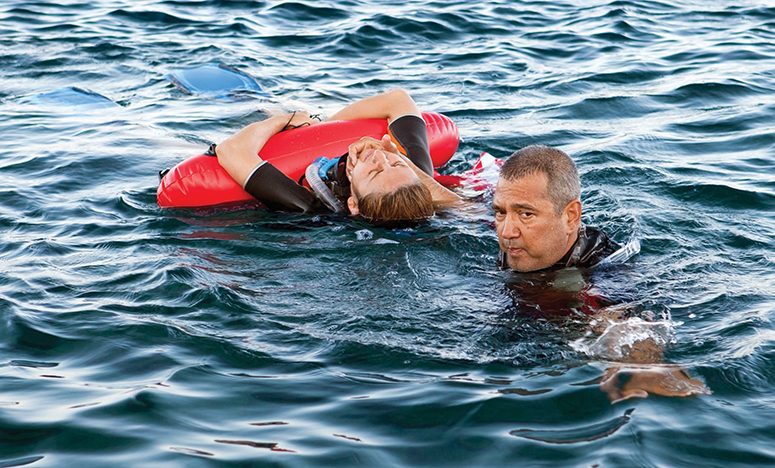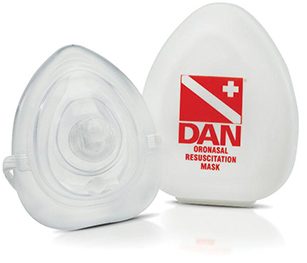Rescuing Divers and Swimmers

Use this information only to supplement skills and knowledge obtained in a formal training course. Do not attempt to rescue injured or distressed divers or swimmers or provide emergency oxygen without formal training.
Performing a Water Rescue
Early recognition and response are critical to a successful outcome in any water rescue. The following are the recommended procedures for making a rescue.
- Ensure your own safety and the safety of the injured swimmer or diver. Be aware of high-risk conditions such as strong currents or tides, limited visibility and hazardous marine life.
- Provide assistance from the surface or shore without entering the water if possible. Try throwing the victim a line, a flotation device or even a small watercraft — all of these items are safer for the rescuer than attempting an in-water rescue.
- Rescues that require in-water assistance can be complicated and typically require knowledge and skills beyond the scope of this guide. The following points, however, highlight a few fundamentals of in-water rescues.
- Solicit topside assistance from observers.
• Enlist bystanders to help spot and track the victim’s position.
• Summon help from emergency medical services or the coast guard.
- Equip the rescuer with appropriate personal safety equipment such as fins, a mask, a snorkel and floatation gear. A rescuer needs to be properly equipped to safely and effectively perform a rescue.
- Assess the distressed swimmer, and communicate with them if possible; this will dictate the following:
• the rescuer’s manner of approaching the swimmer
• the need for physical contact with the swimmer
- Gain control of the situation through verbal communication and/or physical contact with the swimmer.
• Avoid unnecessary physical contact with the swimmer. If they can understand and follow commands, it is sometimes possible to talk someone through a self-rescue.
• Remember that making physical contact with a panic-stricken diver or swimmer can put the rescuer at significant risk.
- Establish positive buoyancy.
• Remove any weight belts and/or drop any heavy loads.
• Inflate both the rescuer’s and the distressed diver’s buoyancy compensators.
- Transfer the swimmer or diver to a boat or the shore while ensuring the following:
• the airway is protected
• everyone maintains positive buoyancy
• the rescuer remains in control
• topside support is ready to assist as necessary
- Begin CPR and rescue breathing, if necessary, as soon as the victim is on a stable surface. Administering CPR in the water is ineffective and will only delay the victim’s extrication from the water.
- Solicit topside assistance from observers.
In general, safe and effective in-water rescues require a degree of skill that can be achieved only through proper training. Numerous organizations offer such courses.
Administering Emergency Oxygen
Respiratory arrest, cardiac arrest, drowning and many dive-related injuries interrupt or impair the cardiovascular system’s ability to supply oxygen to the body’s tissues. In such cases, it is important to administer supplemental oxygen. Victims of dive injuries should receive the highest possible oxygen concentration available. Providing emergency oxygen first aid for injured divers is one of the most important measures to take before professional medical care and hyperbaric treatment are available.
The first step is to assess the diver’s breathing status and then determine the oxygen delivery device that will provide the highest concentration of oxygen possible in the circumstances.

DAN Oronasal Resuscitation Mask
- For breathing injured divers, use one of the following devices:
- a nonrebreather mask with a minimum oxygen flow rate of 15 liters per minute (L/min)
- a demand inhalator valve with an oronasal mask or intraoral mask (Recent research shows that a demand valve with an intraoral mask provides the highest tissue and inspired oxygen levels and is easiest to use.62,63,64)
- any other oxygen delivery device capable of providing
high concentrations of oxygen, such as a closed-circuit
oxygen rebreather
- For nonbreathing injured divers, use an oronasal resuscitation mask (also referred to as a DAN mask) with a minimum oxygen flow rate of 15 L/min.
Any of the devices provides great value in supporting dive activity in remote areas, where long delays in reaching definitive medical aid are likely.
The next step is to properly position the diver to facilitate delivery of
CPR and oxygen first aid. The appropriate position depends on the
diver’s condition.
- Place injured divers who are responsive (able to communicate) in either the recovery position (on one side with their head supported) or a semirecumbent position (comfortably reclining).
- Place injured divers who are unresponsive but still breathing in the recovery position (on either side with their head supported) to help maintain an open airway and to reduce the likelihood that they will aspirate vomitus in their lungs.
- Place injured divers who are unresponsive and not breathing in
a supine position (on their back, face up) so rescuers can perform CPR.
The use of supplemental oxygen should always take place within the context of basic life support (BLS) procedures and should not delay lifesaving techniques such as CPR. DAN highly recommends formal training in administering oxygen first aid, and the information in this guide is not a substitute for such training. For information about training near you, see DAN.org/education-events/instructor-led-courses. Keep in mind that oxygen is a prescription drug in many countries and that the improper handling and maintenance of oxygen equipment can cause serious injury, including death, to both victims and rescuers.
Be aware of the following when using supplemental oxygen on private boats:
- Be sure you have enough oxygen on board to allow for transporting
an injured diver from the farthest dive site to the nearest emergency medical services. - Oxygen first aid is not a substitute for definitive care by a trained health care provider.
- Do not overlook the priority of monitoring the victim’s circulation, airway and breathing while providing emergency oxygen.

Ensure your own safety and the safety of the injured swimmer or diver. Be aware of high-risk conditions such as strong currents or tides, limited visibility and hazardous marine life.

The next step is to properly position the diver to facilitate delivery of CPR and oxygen first aid. The appropriate position depends on the diver’s condition.
DAN Customer Service
Mon–Fri, 8:30 a.m. – 5 p.m. ET
+1 (919) 684-2948
+1 (800) 446-2671
Fax: +1 (919) 490-6630
24/7 Emergency Hotline
In event of a dive accident or injury, call local EMS first, then call DAN.
24/7 Emergency Hotline:
+1 (919) 684-9111
(Collect calls accepted)
DAN must arrange transportation for covered emergency medical evacuation fees to be paid.
Medical Information Line
Get answers to your nonemergency health and diving questions.
Mon–Fri, 8:30 a.m. – 5 p.m. ET
+1 (919) 684-2948, Option 4
Online: Ask A Medic
(Allow 24-48 hours for a response.)